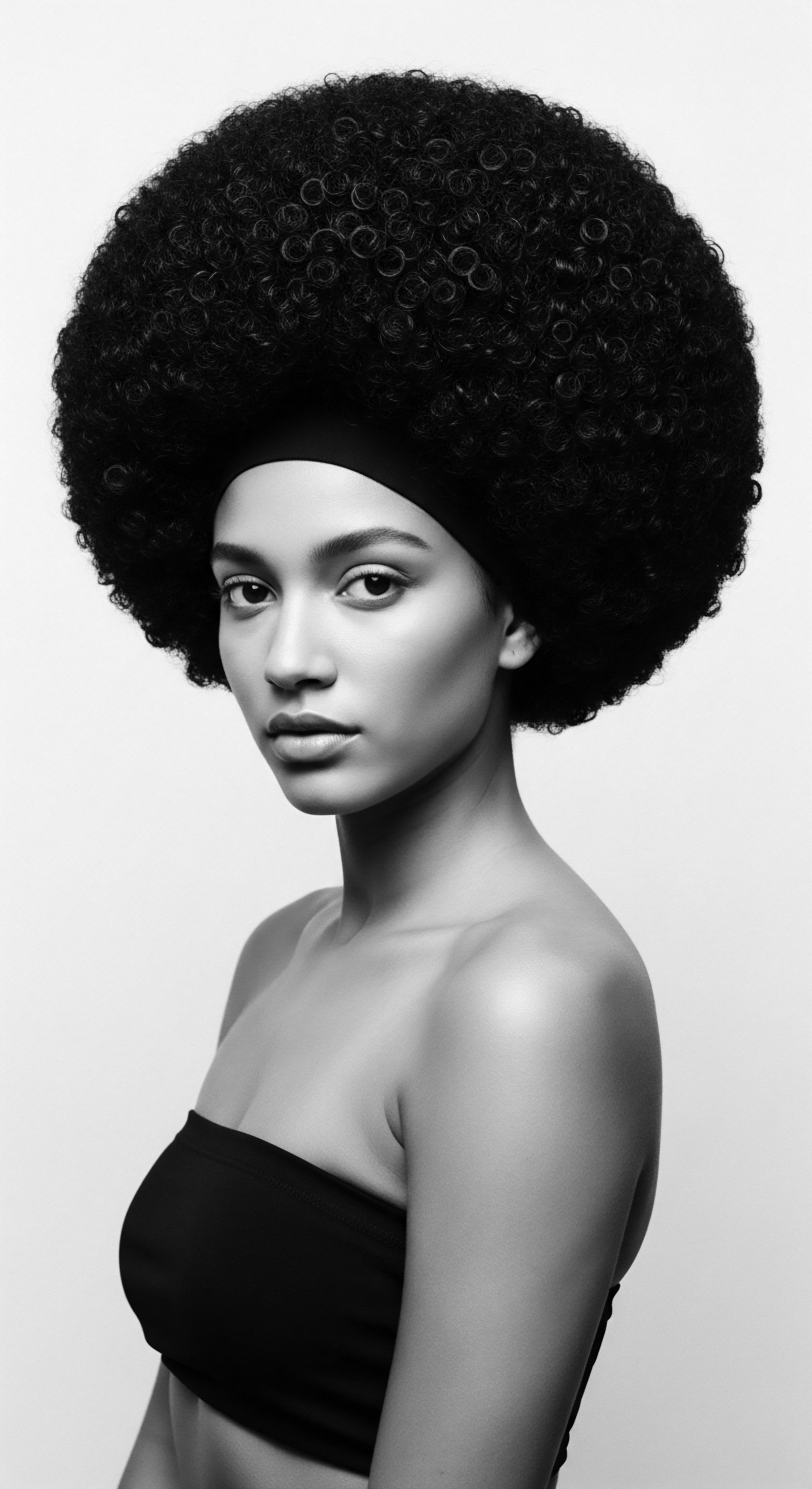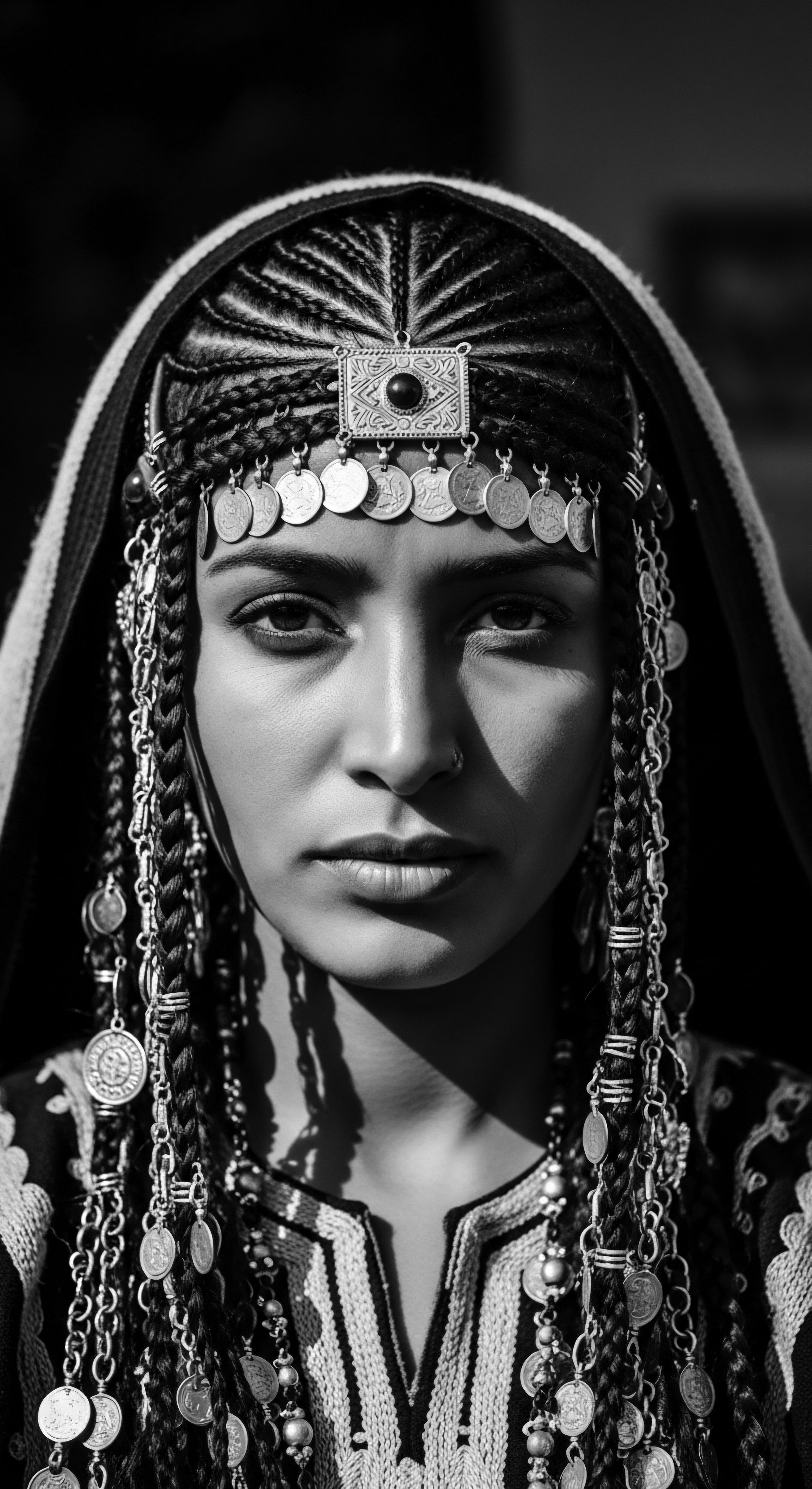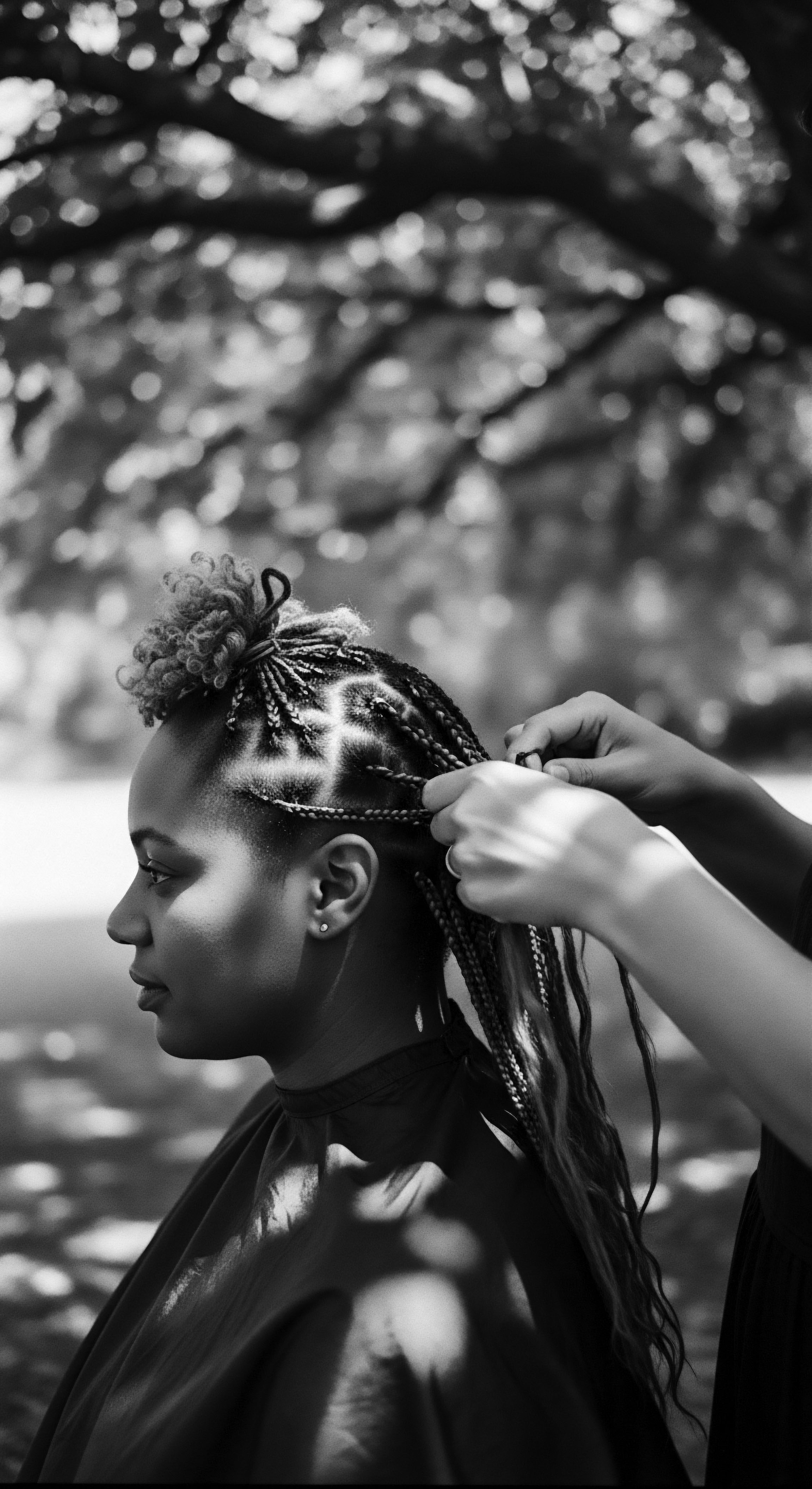
Fundamentals
The Cross River Region, a vibrant expanse nestled at the southeastern edge of Nigeria and stretching into southwestern Cameroon, stands as a testament to the profound interconnectedness of culture, environment, and personal identity. This geographic space, shaped by the Cross River itself, has long been a crucible of human ingenuity, particularly when contemplating the heritage of textured hair. To comprehend the Cross River Region in the context of hair is to delve into a deep, layered understanding of how ancestral practices, communal bonds, and individual expressions coalesce around the very strands that spring from the scalp. It is not merely a geographical marker; it represents a living archive of aesthetic principles and spiritual values.
For communities inhabiting this land, including the Ejagham , Efik , Ibibio , Annang , and Oron peoples, hair has always held a meaning far beyond surface appearance. It is a vital component of the self, a visible chronicle of lineage, status, and life’s passages. The region’s lush rainforests and diverse ecosystems offered an abundance of natural bounties.
These natural gifts were ingeniously transformed into ingredients for elixirs and concoctions designed to nourish, protect, and adorn hair. Early inhabitants mastered the art of extracting oils from nuts and seeds, identifying plants with cleansing or conditioning properties, and blending these into preparations that spoke to an intimate knowledge of the hair’s intrinsic structure and requirements.
The Cross River Region’s understanding of hair stems from a profound reverence for nature’s bounty and an ancient recognition of hair as a living extension of identity.
This foundational understanding of hair as a sentient part of one’s being, deserving of deliberate care and attention, echoes from the earliest days of human settlement. The environment guided the initial exploration of hair care, influencing the selection of materials and the development of techniques. It was a symbiotic relationship ❉ the earth provided, and the people, in turn, revered and utilized these gifts to honor their bodies and spirits.
The practice of hair care in these nascent communities was intrinsically tied to everyday rhythms. It was often a communal activity, passed down through generations. Grandmothers taught daughters, and daughters taught their own, forging a continuous chain of wisdom.
This transmission of knowledge, often through oral tradition and hands-on guidance, ensured that each generation inherited a treasury of skills and insights concerning the maintenance and styling of textured hair. This heritage represents an elemental knowledge, grounded in a reciprocal relationship with the natural world, serving as the very source of later, more intricate practices.
Traditional hair care practices in the Cross River Region involved a harmonious balance of cleansing, conditioning, and artistic expression. The specific needs of textured hair, with its unique coil patterns and hydration requirements, were intuitively understood and addressed through these ancestral methods. This deep comprehension, born of centuries of observation and refinement, set the stage for the sophisticated hair culture that subsequently flourished within the region.

Ancestral Ingredients and Their Uses
The Cross River Region’s diverse plant life was a veritable pharmacy for hair. Ancestral healers and beauty practitioners recognized the properties of various botanical elements, transforming them into potent treatments.
- Palm Kernel Oil ❉ Derived from the fruit of the oil palm, this rich oil was a staple, valued for its moisturizing and strengthening qualities, providing a natural sheen and softness to the hair.
- Shea Butter ❉ Though more prevalent in other West African regions, variations of similar nourishing plant butters were utilized locally for their emollient properties, sealing moisture into thirsty strands and shielding them from environmental elements.
- Herbal Infusions ❉ Leaves and bark from specific local trees, steeped in water, created rinses that cleansed the scalp, promoted healthy hair growth, and imparted a subtle aroma.

Early Hair Adornment
Beyond care, hair became a canvas for storytelling and social markers. Early forms of adornment were often simple yet profoundly significant.
- Beads and Cowries ❉ These natural elements were woven into braids or coils, signifying wealth, status, or spiritual protection.
- Natural Dyes ❉ Pigments extracted from plants, often used for body art, also found their way into hair to enhance color or mark ceremonial readiness.
- Clay and Earth Pigments ❉ Applied for texture, volume, and protective qualities, these minerals also added symbolic meaning to hairstyles.

Intermediate
The narrative of the Cross River Region’s hair heritage extends into a living testament, where hair care transforms into a tender thread woven into the fabric of daily life and communal ceremony. The intermediate understanding of the Cross River Region’s meaning in this context reveals the dynamic interplay between the individual and the collective, where hair serves as a profound expression of identity, connection, and societal belonging. The traditions here are not static echoes from a distant past; they are vibrant, evolving practices that continue to shape perceptions of self and community.
In these communities, hair styling sessions were, and often remain, opportunities for intergenerational exchange. Under the gentle hands of an elder, children and young adults learned not only techniques but also the stories, proverbs, and values attached to each twist, braid, or coil. The creation of a hairstyle could take hours, fostering intimate conversations and strengthening familial bonds.
It was a time for shared laughter, whispered secrets, and the quiet transmission of cultural wisdom. This shared activity underscores the notion that hair care extends beyond mere physical upkeep; it is an act of communal nurturing and cultural preservation.
Hair practices in the Cross River Region exemplify a profound cultural tapestry, where communal acts of care transmit ancestral stories and reinforce collective identity.
The diverse ethnic groups within the Cross River basin each contribute distinct patterns and rituals to this rich hair heritage. The Efik people, for instance, known for their elaborate ceremonial attire, incorporated intricate hair designs that spoke to their social standing and spiritual connections. The Ibibio , with their vibrant masquerades and artistic expressions, often reflected their communal values and spiritual beliefs through their hair adornment. The Annang and Oron communities also possessed unique methods of styling and maintaining their hair, using local flora and traditional implements that had been refined over countless generations.

Hair as a Symbol of Life Stages
Hair in the Cross River Region frequently served as a visual marker of life’s transitions, signifying rites of passage from childhood to adolescence, marriage, motherhood, and elderhood. A young woman’s change in hairstyle could announce her readiness for marriage, while a particular style might signify mourning or celebration. These visual cues acted as a silent language, conveying complex social information within the community.
| Life Stage Childhood |
| Traditional Hair Expression Simple plaits or shaven patterns |
| Cultural Significance Purity, protection, identification of lineage. |
| Life Stage Initiation/Adolescence |
| Traditional Hair Expression Elaborate, often temporary, styles (e.g. Moninkim) |
| Cultural Significance Readiness for adult responsibilities, beauty, eligibility for marriage. |
| Life Stage Marriage/Motherhood |
| Traditional Hair Expression More complex, enduring styles; often adorned with cowries or symbols of fertility |
| Cultural Significance Status, commitment, prosperity, family continuity. |
| Life Stage Elderhood |
| Traditional Hair Expression Styles reflecting wisdom, respect, simplicity; often silvered strands honored |
| Cultural Significance Revered knowledge, spiritual connection, leadership role within the community. |
| Life Stage These expressions illustrate how hair transcended mere aesthetics, embodying the lived experiences and communal values of the Cross River peoples. |
The materials used in hair adornment were also imbued with symbolic value. Cowrie shells, once a form of currency, conveyed prosperity. Beads, often intricately woven, spoke of social standing and aesthetic preference.
The application of red camwood paste, while protective, also carried spiritual connotations, shielding the wearer from ill will and connecting them to ancestral energies. This holistic approach, where physical well-being and spiritual alignment were intertwined, is a hallmark of the Cross River Region’s hair knowledge.
Within this vibrant cultural landscape, hair care routines became rituals of self-affirmation and collective reinforcement. The shared experience of braiding, oiling, and adorning hair fostered a sense of belonging, a recognition of shared heritage. Even as the outside world shifted, these practices endured, offering a constant anchor to tradition and identity.
The resilient nature of textured hair itself mirrored the enduring spirit of the people, capable of intricate transformation while retaining its elemental strength. This unwavering commitment to traditional methods, even in the face of external influences, speaks volumes about the deep-seated respect for ancestral wisdom in the Cross River Region.

Academic
The academic definition of the Cross River Region, when interpreted through the lens of textured hair heritage, reveals a complex, multi-layered system of social, spiritual, and aesthetic communication. This region is not simply a geographical locale; it serves as a critical site for ethnological studies, providing unparalleled insights into the nuanced interconnections between corporeal adornment, codified knowledge systems, and socio-political structures in African societies. Here, hair’s capacity for meaning-making reaches its apogee, extending beyond personal expression into the very framework of communal identity and governance.
A rigorous examination of the Cross River Region necessitates a deep exploration of its indigenous knowledge systems, particularly the Nsibidi script . This ideographic writing system, primarily associated with the Ejagham people , yet widely disseminated among the Efik , Ibibio , and Igbo communities within the broader Cross River basin, offers a unique window into the region’s intellectual and artistic traditions. Nsibidi is not a spoken language; it is a system of symbols, pictorial and abstract, that can be expressed across various mediums ❉ drawn on walls, carved into wooden artifacts, etched onto calabashes, tattooed onto skin, and, profoundly, integrated into hair designs. This fluid application across diverse materials and contexts makes Nsibidi a dynamic and adaptable system of communication.
Nsibidi, as an ancient ideographic system, transforms hair into a dynamic canvas for encoded cultural narratives and spiritual declarations.

Nsibidi as Hair Artistry and Historical Example
The integration of Nsibidi symbols into hair artistry in the Cross River Region stands as a powerful historical example of hair’s role as a repository of cultural knowledge and social commentary. Among the Ejagham, for instance, elaborate hair constructions were not merely decorative; they were living expressions of Nsibidi, conveying specific messages, affiliations, and status within secret societies such as the Ekpe (Leopard) Society . These societies, historically, held significant social, political, and judicial power, and their members communicated through a complex lexicon of Nsibidi signs, some of which were public, others esoteric and restricted to initiates.
Consider the Moninkim dance, a coming-of-age ceremony among the Ejagham, where young women underwent periods of seclusion and rigorous training in mother-craft and social morals. The culmination of this initiatory phase involved a public presentation, during which the Moninkim’s hair was meticulously plaited into specific forms, often four mounds, adorned with bands, porcupine spikes, or feathers. These hairstyles, documented in anthropological accounts, were not arbitrary choices; they were designed to reflect the maiden’s journey, her purity, fertility, and readiness for marriage, often incorporating Nsibidi symbols that would be recognizable to those privy to the tradition’s deeper meanings. The hair, thus, became a palpable testament to their transformation and the embodiment of communal virtues.
The long-term consequences of this deep connection between hair and Nsibidi extend beyond the aesthetic. The use of hair as a medium for this complex script ensured its transmission across generations, even in the absence of formal written records in the Western sense. The very act of styling became a pedagogical one, silently reinforcing communal values and preserving historical memory. This continuity is remarkable, particularly when considering the disruptive forces of colonialism and the transatlantic slave trade.
Indeed, Nsibidi, carried by enslaved individuals from the Cross River region, resurfaced in the diaspora, influencing symbolic systems in Afro-Cuban and Haitian traditions like anaforuana and veve . This transnational dissemination is a profound testament to the script’s resilience and the enduring power of hair as a vehicle for cultural memory, even across forced migrations. It underscores how traditions, even those intricately tied to a specific geographic locale, possess an inherent capacity for adaptation and re-manifestation in new contexts.
From an academic vantage point, the study of Cross River hair practices necessitates an interdisciplinary approach, drawing upon anthropology, art history, linguistics, and ethnomedicine. It allows scholars to understand not only the semiotics of hair—how it communicates meaning—but also the ethno-scientific knowledge embedded in traditional hair care ingredients and techniques. For instance, the use of palm kernel oil, widely employed in the region, finds contemporary scientific validation for its emollient properties and fatty acid composition, demonstrating how ancestral wisdom often aligns with modern dermatological understanding.

Interconnectedness of Hair, Identity, and Knowledge
The Cross River Region offers a compelling case study for examining how corporeal artistry, specifically hair styling, functions as a mechanism for knowledge transfer and social cohesion. The meticulousness with which certain hairstyles are created, often involving hours of communal effort, signifies the high societal value placed on these expressions. The act of creation itself becomes a ritualized performance, where the practitioner, through her hands, inscribes cultural narratives onto the recipient’s head.
Moreover, the dual nature of Nsibidi—with its sacred, restricted forms and its public, decorative variations—is particularly salient when applied to hair. Certain styles, perhaps those worn by initiates of secret societies or during specific rituals, would convey profound, hidden meanings to those with the requisite knowledge. Other styles, while still artistic and beautiful, would carry more generalized cultural affirmations, accessible to a broader audience. This duality highlights a sophisticated understanding of information control and stratified knowledge within these societies, with hair serving as a visual interface for both revelation and concealment.
The longevity of Nsibidi as an active symbol system, integrated into hair art from at least the 5th to 15th centuries (based on archaeological evidence on pottery and headrests) through to contemporary usage on textiles and in masquerades, attests to its enduring cultural significance and its adaptability. The ability of these symbols to transcend generations and even continents—reaching communities in Cuba and Haiti through the transatlantic slave trade—is a powerful testament to the resilience of cultural heritage. It underscores how hair, as a tangible and highly visible medium, played an instrumental part in preserving this intellectual legacy. The continuity of Nsibidi is not merely a historical footnote; it is a living example of how deeply embedded cultural practices continue to influence identity and creative expression.
| Application Realm Hair Artistry |
| Description of Connection to Nsibidi & Hair Plaited into geometric patterns, adorned with symbols signifying status or initiation status, such as in Moninkim ceremonies. |
| Cultural Implications Identifies individuals with specific societies or life stages; serves as a non-verbal communication system. |
| Application Realm Body Adornment (Tattoos) |
| Description of Connection to Nsibidi & Hair Nsibidi symbols inscribed as permanent or temporary tattoos on the skin, including the face. |
| Cultural Implications Marks lineage, spiritual protection, or affiliation with secret societies, visible social markers. |
| Application Realm Ukara Ekpe Cloth |
| Description of Connection to Nsibidi & Hair Indigo-dyed cloth woven with Nsibidi symbols, worn by members of the Ekpe society. |
| Cultural Implications Signifies membership, status, and power within the Ekpe society; a portable lexicon of sacred knowledge. |
| Application Realm Masquerade Masks & Headdresses |
| Description of Connection to Nsibidi & Hair Carved masks often covered with skin and adorned with elaborate hairstyles, sometimes incorporating Nsibidi motifs. |
| Cultural Implications Connects the spiritual realm to the physical; provides visual representation of ancestors or powerful entities. |
| Application Realm The enduring presence of Nsibidi across these mediums affirms hair's indispensable role in preserving and transmitting the profound cultural knowledge of the Cross River Region. |
In analyzing the meaning of the Cross River Region, particularly from an academic perspective on hair, one recognizes a deep cultural investment in the hair as a vital communicative organ. The practices here are not merely about aesthetics; they represent a sophisticated cultural infrastructure where hair operates as a medium for transmitting complex philosophical, social, and spiritual concepts. The region’s historical and ongoing connection to textured hair heritage serves as a powerful lens through which to understand the resilience of African traditions and their profound influence on global cultural landscapes.

Reflection on the Heritage of Cross River Region
The journey through the Cross River Region, viewed through the delicate yet resilient strands of textured hair, concludes not with a definitive end, but an open-ended contemplation. It is a reflection on how deeply heritage shapes us, how ancestral wisdom continues to echo in our modern lives, and how the tender care we bestow upon our hair connects us to a continuous lineage of knowledge. The exploration of this vibrant African landscape—its peoples, their practices, and their enduring symbolic systems—reveals that hair is not merely a biological extension; it stands as a profound testament to identity, resilience, and the unbound helix of cultural memory.
The practices of the Cross River peoples offer us more than historical anecdotes; they provide a blueprint for mindful living and a deep appreciation for the intrinsic worth of our heritage. From the elemental biology understood by ancient hands, to the intricate Nsibidi symbols woven into celebratory and ritualistic coiffures, the region presents a holistic understanding of self that prioritizes harmony with nature, communal bonds, and spiritual connection. The hair, in this context, becomes a living artifact, a dynamic scroll upon which stories are inscribed and passed down through generations.
In each gentle detangling, in every intentional application of a nourishing balm, there is an opportunity to honor this deep ancestral wisdom. The knowledge that specific hairstyles once communicated social status, marked rites of passage, or even encoded complex ideograms, transforms a simple act of hair care into a ritual of reconnection. It encourages us to look beyond commercial trends, recognizing the profound value embedded in traditions that prioritize genuine health and authenticity over fleeting fads. This awareness invites a conscious engagement with our hair, treating it not as a problem to be solved, but as a sacred inheritance to be celebrated and nurtured.
The Cross River Region reminds us that our hair carries echoes of our ancestors—their ingenuity, their struggles, and their triumphs. It prompts us to consider the ways in which we, in our contemporary lives, can continue to honor this legacy. Perhaps it involves seeking out traditional ingredients, learning ancestral techniques, or simply dedicating moments of quiet reverence to our hair as a part of our holistic well-being.
It is a call to recognize the power held within each strand, a power that has always linked us to our past and continues to guide us towards a future where our cultural heritage is not only remembered but actively revitalized and cherished. The story of hair in the Cross River Region is a continuous narrative, inviting each of us to find our own place within its timeless flow.

References
- Ajibade, B. Ekpe, E. & Bassey, T. (2012). More than Fabric Motifs ❉ Changed Meaning of Nsibidi on the Efik Ukara Cloth. Mediterranean Journal of Social Sciences, 3(2), 297.
- Benson, I. E. (n.d.). The Origin of Ekpe Masquerade and the Nsibidi Symbols in Southern Nigeria. IDOSR Journals.
- “Crest Helmet. Ejagham people, Ekoi subgroup.” (early 20th century). Google Arts & Culture, The Toledo Museum of Art.
- Lekan. (2017). The Cultural Value of Nsibidi in the Contemporary Era. IDOSR Journal of Arts and Management, 2(3), 1-7.
- Okpu, O. (2015). Nsibidi ❉ An Artistic Expression and Communicative System in South Eastern Nigeria. International Journal of Research in Humanities and Social Studies, 2(4).
- “A Research on Moninkim Dance of the Ejagham People of Nigeria and Cameroon.” (2016-06-28). University of Calabar.
- Talbot, P.A. (1912). In the Shadow of the Bush. William Heinemann.
- The Republic. (2024, November 24). The Reinvention of Nsibidi.
- IISTE.org. (2015, April 2). Nsibidi ❉ An Artistic Expression and Communicative System in South Eastern Nigeria.
